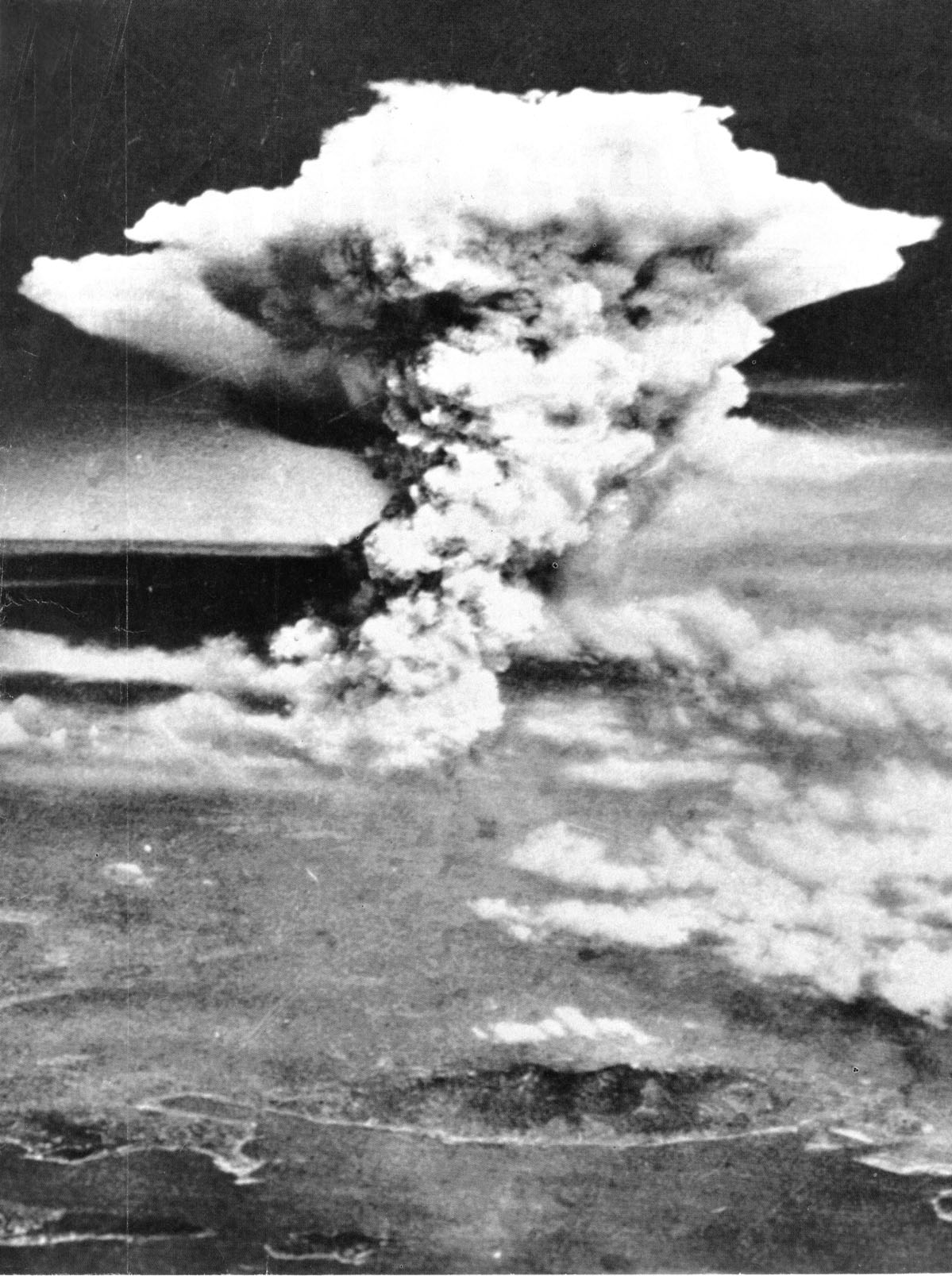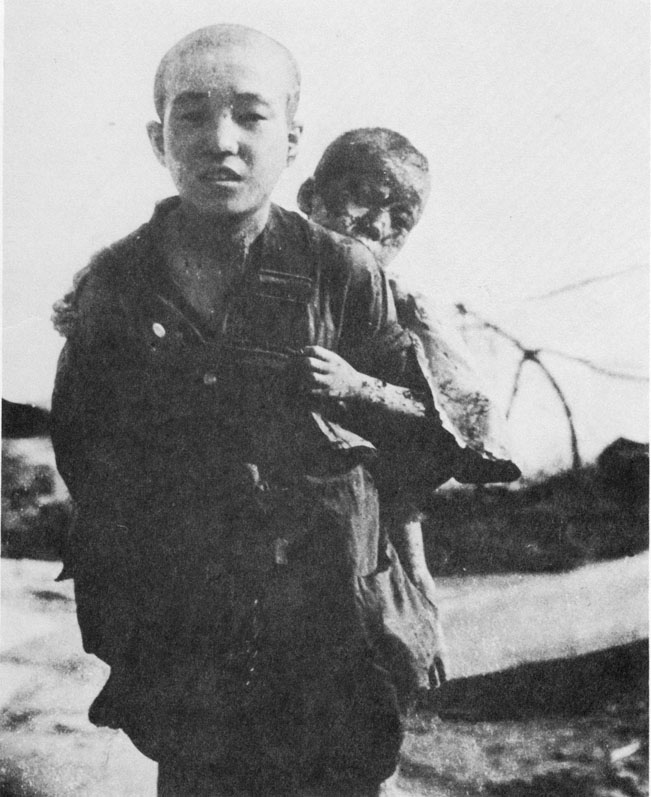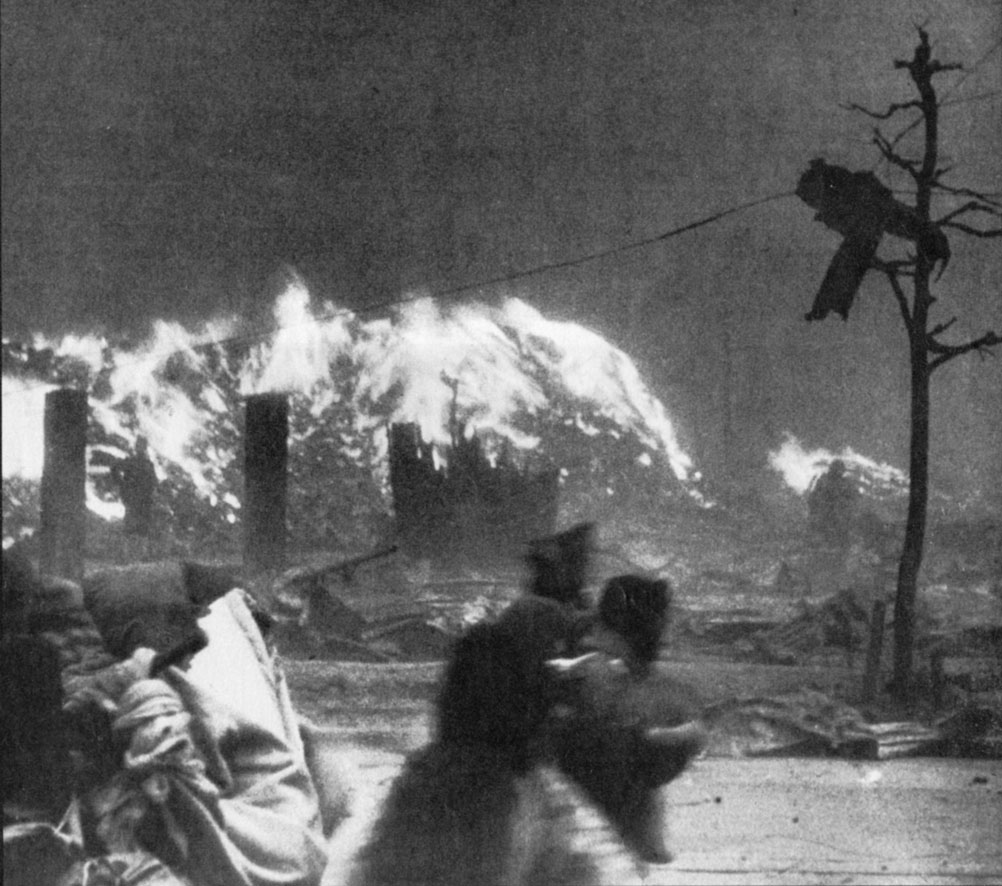This is the first in a new series for Revolution.
April 25, 1945, U.S. Secretary of War Henry Stimson met with the new president Harry S. Truman to brief him about a major military secret. “Within four months,” Stimson said, “we shall in all probability have completed the most terrifying weapon ever known in human history.”
This briefing lasted 45 minutes. There was no debate over whether to use this weapon. The leaders of the United States condemned tens of thousands to an awful death without hesitation.
Sixty years ago this month, on August 6, 1945, the U.S. military plane Enola Gay circled over Hiroshima, and released a single bomb. It plunged toward the Japanese city below and detonated in an enormous fireball as hot as the sun. At Ground Zero almost everything was simply destroyed and every human being died. Even two miles from the blast, human skin was severely burned.
The wind blew at 1,000 miles per hour—shattering the bodies of thousands of people as it hurled them through the air or brought buildings crashing down upon them.
When the firestorm died down, the former city was a scorched plain. A heavy black rain brought radioactive dust back down to earth. Some of the dead had been vaporized, many others lay where they died, in their thousands and thousands.
When President Harry Truman was told of the Hiroshima bombing, he said, “This is the greatest thing in history.”
The U.S. high command felt that the destruction of one city was still not enough. Three days later, also without warning, they dropped a second bomb on the city of Nagasaki.
Long after the bombing, people kept dying, from a then-mysterious illness — radiation. Five months after the bombing 140,000 people had died in Hiroshima and 70,000 in Nagasaki.
Crimes in the Name of Safety and Freedom
How was this horror excused? How did the U.S. government and military try to convince their soldiers to fight, their bomber crews to bomb, and the people of the “civilian home front” to back all of this?
The people of the U.S. were told that this war against Japan was a war of self-defense. They were told that they faced invasion from Japan—and that “the enemy” was vicious, fanatical, and barely human.
People were told that the expanded American war machine would defend their homes and “the American way of life.” They also were told that this war was “bringing freedom and democracy” to the world.
Official U.S. mythology teaches the U.S. armed forces are always the “good guys,” guided by the purest motives.
This is one of the world’s greatest lies—covering a truly shameful history. And this war in the Pacific, including the horrific bombings of Hiroshima and Nagasaki, is a vivid example.
The Pacific war was part of a much larger world war—where many different class forces, much of the planet and all its major powers were all drawn into a bitter series of interconnected wars. It is beyond the scope of this article to analyze all of that. But we can see, from a closer look at just the Pacific theater of that world war (where the U.S. and its allies fought with the Japanese) how all these U.S. justifications for war were deceptions covering the real motives and goals.
Not Defense, But Imperialism!
By the time World War 2 broke out, the United States had already been fighting for control in the western Pacific for over half a century. The U.S. brutally conquered the Philippines in the early 1900s and demanded an “open door” into China —to exploit those countries without barriers.
Japan emerged as a rival power—similarly eager to dominate China, Korea, the Philippines, and the rest of this region. The U.S. built a “deep water navy” to “project power” to eastern Asia. And when the Japanese military built a navy to rival all that, and when Japanese troops took over parts of China in the 1930s—driving out U.S. and British “interests” — then it became pretty clear to everyone in power (in both Washington and Tokyo) that a showdown (and probably war) was coming.
But we have all been taught that the main issue was that Japan attacked first at Pearl Harbor.
In fact, you can’t correctly analyze the wars by “who hit first” or even “who is fighting on whose soil.” You have to evaluate them by the goals and class interests that various forces are fighting for. This Pacific war came out of an imperialist rivalry, rooted in capitalism’s drive to “expand or die.” It was a war over which powers would dominate and exploit hundreds of millions of people—and this makes the U.S. war for the Pacific unjust, no matter which of these rivals ended up landing the first blow.
And there is much evidence that powerful forces in the U.S. government were quite excited when the Japanese navy attacked Pearl Harbor—because it now gave them a public justification for the war they had long wanted to launch.
And all this talk of Pearl Harbor being “sacred American soil” is especially grotesque once you look into the way the U.S. military conquered Hawai’i from its own people.
Promising Liberation, Delivering Domination
In history books and war movies, people are told that U.S. marines went “island hopping” through the Pacific to “liberate” the people. The colonial master Douglas MacArthur is portrayed as a hero when he promised “I shall return” (to the Philippines he had ruled at gunpoint!).
But the U.S. was fighting for domination, not liberation.
Look at what happened after the war. The U.S. took over the Philippines again, and eventually became the main power in Singapore, South Vietnam, Indonesia, Taiwan, and South Korea. The U.S. also tried to replace Japan as the power dominating China, but the people of China prevented that through the great revolution led by Mao Tsetung!
The victorious U.S. imposed a series of brutal regimes, including the notorious Marcos government, that tortured the Filipino people over the following decades. Look at the history of Indonesia or South Korea.
The U.S. victory in World War 2 meant more brutal domination, not liberation, for these countries. Generations sweated in the fields and sweatshops, women were crudely sold around U.S. bases, and brutal regimes were propped up by U.S. aid and guns.
And today, U.S. domination is still going on!
Bringing Democracy to the Conquered
During the current war in Iraq, U.S. war-makers like Paul Wolfowitz have said they intend to “bring democracy to the Middle East” and point to U.S. post-war policies in Japan as a model. And it is a way of saying that the U.S. may do terrible things in war, but their victory always means good things in the end.
Is this true? No.
After Hiroshima and Nagasaki (and the Japanese surrender), the U.S. occupied Japan and imposed a new arrangement that included a political system with elections.
But this bringing of democracy was constructed to serve the political and strategic interests of the U.S. First, great care was taken to make sure that Japan remained a capitalist class society. Much of the hateful, oppressive old Emperor system was preserved—and in particular, the Emperor himself was not removed from power.
New political forces were allowed to form and allowed to contend for power as long as they were committed both to capitalism generally and the pro-U.S. strategic arrangement in particular. Revolutionary political forces who opposed all that were suppressed, and important workers strikes were simply banned.
The new Japanese government was not allowed to create a large new military that could ever challenge the U.S., but the Japanese ruling class of monopoly capitalists was allowed to share in the exploitation of the surrounding poorer countries.
In short, the democracy that the U.S. brought to Japan was a bourgeois democracy— designed to prevent revolution, preserve capitalism, and create a Japan in keeping with U.S. interests.
Saving Lives with Mushroom Clouds?
It is particularly shocking when these U.S. war- makers claim their treatment of the Japanese people could be a model for Iraq and the Middle East. As if no one remembers Hiroshima and Nagasaki! As if the world will accept their lame, shameful and still- unapologetic justifications of those bombings!
Officially, the U.S. government claims that these atomic bombs were dropped to “save lives” (meaning, of course, American lives)!
The U.S. military (and its apologists) claim that many U.S. soldiers would have died, if the U.S. had “been forced to invade” Japan’s home islands. And so the atomic mass killing of tens of thousands of civilian Japanese (in their heartless calculations) are treated as if it is a good trade-off. And in such ways, then and now, people of the U.S. are trained to think that mountains of dead bodies are quite fine, as long as they are not American bodies.
And, in fact, all this talk was a lie. By August 1945, the Japanese military and empire were on the verge of collapse—and the conditions were ripe for a negotiated end to the war. Where did this need come from to directly occupy Japan and drop these atomic bombs—it came from what the rulers of the U.S. saw was in their interests.
The U.S. ruling class wanted complete surrender of Japan and long-term occupation—because they were after unquestioned domination—both of Japan itself and the whole vast surrounding region. They were using the most gruesome means to grab complete victory for their global ambitions, and yet claiming to do all this in the name of the people of the U.S.
They wanted to remake Japan in ways that would prevent future rivalry. And they wanted to end this war with a great show of ruthless strength—leaving piles of scorched and radioactive bodies—to send a message to anyone who might still think about challenging the U.S. in the postwar world.
The people of Hiroshima and Nagasaki were sacrificed—wiped out in great fireballs—to deliver a gangster threat to the then-socialist Soviet Union (which was preparing to launch military moves in east Asia) and to the restless colonized people of the western Pacific, especially the communist- led revolutionary movement of China.
Those who rule the U.S. today still try to excuse the destruction of Hiroshima and Nagasaki—and claim these mass murders were all for the greater good.
“Fighting for freedom”? “Fighting to defend America”? No. The atomic bombing of Hiroshima and Nagasaki are among the most bloodthirsty and brutal acts in human history—and they were all about expanding the reach and profits of U.S. capitalism and its imperialist grip on much of the world.



Above: Survivors fleeing the firestorm after the atomic bombing of Hiroshima, 1945.